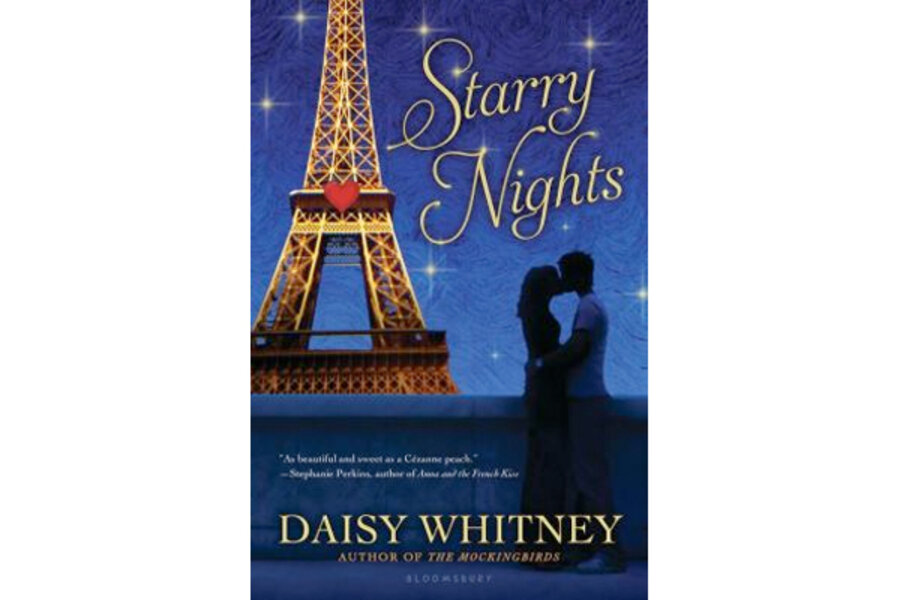Starry Nights
Paris is a city mythologized by art, a city that makes magic of the mundane: rain, accordion music, even heartaches. Daisy Whitney's charming new young adult novel Starry Nights tells the story of Julian Garnier, a young French artist who, embittered by a recent breakup and suffering a crisis of artistic confidence, turns to his city for solace.
Truth be told, Julien’s a bit of a fretter. He worries that his art is technically accurate but lacks feeling. He doubts that he has the talent to be a professional artist, but he loves art too much to do anything else. For a self-professed nonreligious guy, art is his religion and museums are his temples. It’s in his beloved Musée d’Orsay that Julien sees paintings come to life before his eyes.
It all begins when the museum is selected to show "The Girl in the Garden," a (fictional) Renoir painting that was lost for 130 years. Legend has it that Renoir and Monet, both married men, were in love with the subject, and that the girl’s family hid the painting to protect her reputation. As a part-time guide at the Musée d’Orsay (and son of its director), Julien has unparalleled access to the museum at all hours. On a late night visit, a peach falls out of a Cezanne still life and a Degas ballerina practices Swan Lake in the gallery.
Julien befriends the son of the painting's owner, a cross-dressing artist who keeps sheep on his Montmartre balcony and calls himself Bonheur (after cross-dressing realist painter Rosa Bonheur). Bonheur knows that Julien can see art coming to life and offers to show him the lost Renoir before it goes on display. Julien accepts and watches in shock as a hand extends through the canvas: a real girl named Clio is trapped inside the painting by a powerful curse.
At the same time, paintings across the world are mysteriously falling ill. All the Renoirs are fading. The mirror in a Titian is fractured. In the Louvre, Géricault’s "The Raft of the Medusa" is leaking water into its gallery, and Rembrandt’s characteristically full-figured Bathsheba is wasting away in her frame, shedding shriveled bits of flesh onto the floor.
Julien learns that Bonheur and his sister are members of a secret society called the Avant Garde, sworn to protect art and the nine divine Muses who inspire it – the Muses who evidently live in Bonheur’s basement. According to them, Julien is the first-ever human muse and the only one who can break the curse.
On Clio’s first night at the museum, she emerges for the first time in over a century and finds Julien waiting for her. He comes to her every night after the museum closes, bringing pastries to fill her very real, very empty tummy. They fall in love while roaming the galleries with the living art and traveling into the paintings.
“There is magic somewhere in Paris,” he declares. “There is clearly magic in art, magic in dust, magic in my hands.”
Together they must heal the world’s sick art and free Clio. To do that, they’ll have to go up against Pierre-Auguste Renoir himself – Renoir’s ghost has inhabited the body of a local street artist, determined to protect his legacy at all costs. The lovers’ struggle will demand a greater sacrifice than they can imagine.
Having never been to France or visited the Louvre or the Musée d’Orsay, I reveled in Whitney’s command of her subject. A Brown University art history graduate, Whitney clearly has a passion for Paris. Her descriptions of Saint-Germain-des-Prés, Giverny, Montmartre, and the Marais are practically caresses.
Unfortunately for readers with empty stomachs, she’s also well versed in French pastry. Whitney concocts a delectable buffet of apricot tart, cinnamon rugelach, five-berry crumble, macarons, and île flottante (meringue afloat in a sea of caramel custard).
I was pleased that the litany of art references never felt like name-dropping. Julien and Clio interact with Manet’s "Olympia," Van Gogh’s "Portrait of Dr. Gachet" and "Starry Night" (naturally), Toulouse-Lautrec’s "Dancing at the Moulin Rouge," and more. We hear of Renoir’s "The Swing and Dance" at Bougival, Monet’s Rouen cathedrals and Japanese bridges. They wander through Turner, Goya, Morisot, and Jackson Pollock. Julien even stops by Edward Hopper’s "Nighthawks" for a milkshake.
Whitney has a wicked sense of humor – she decides that Pollock was painting expired food in his refrigerator and that the Mona Lisa is smirking at a dirty joke. Just be willing to take her portrayal of Renoir with a grain of salt. Fans might rankle at the concept of a jealous elitist who returns as a body-possessing ghost.
Given the pastry parade, I found myself likening the book to a tray of profiteroles. It was beautiful, sweet, a bit fluffy, and irresistible to devotees, but with some unexpected hollow spots. The Parisian teens use a jarring amount of American slang: "mad skills," "hits the spot," "really dig," "goes out on a limb," using “she was all like” instead of “she said.” Julien even orders French fries, which in France, of course, are just "frites" or "pommes frites" (fried potatoes). I love to immerse myself in a novel’s culture and this proved an annoying distraction.
In addition, Clio behaves anachronistically for a 19th-century girl, kissing Julien, using air quotes, and knowing what “clubbing” is without needing to ask. Yet Whitney tries to emphasize that their “cultural touchstones” are different, giving Clio a blank look when Julien mentions Spider-Man. It’s another weak point in an otherwise charming novel.
If you appreciate art history, Paris, or French pastry (and is there really anyone who doesn't?), you’ll enjoy "Starry Nights." Turn on some Eartha Kitt, keep an art history book close by, and read with a warm chocolate croissant.






